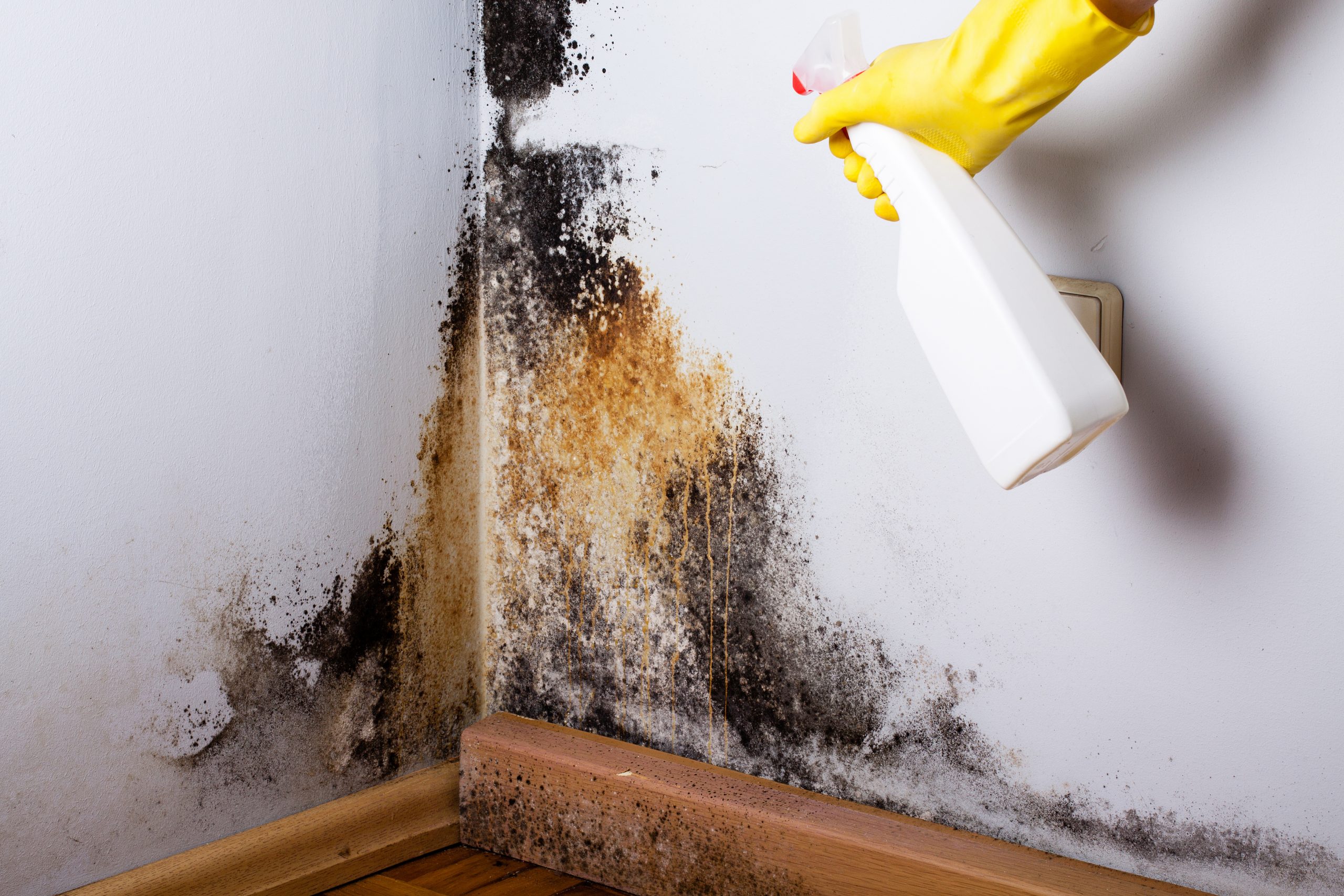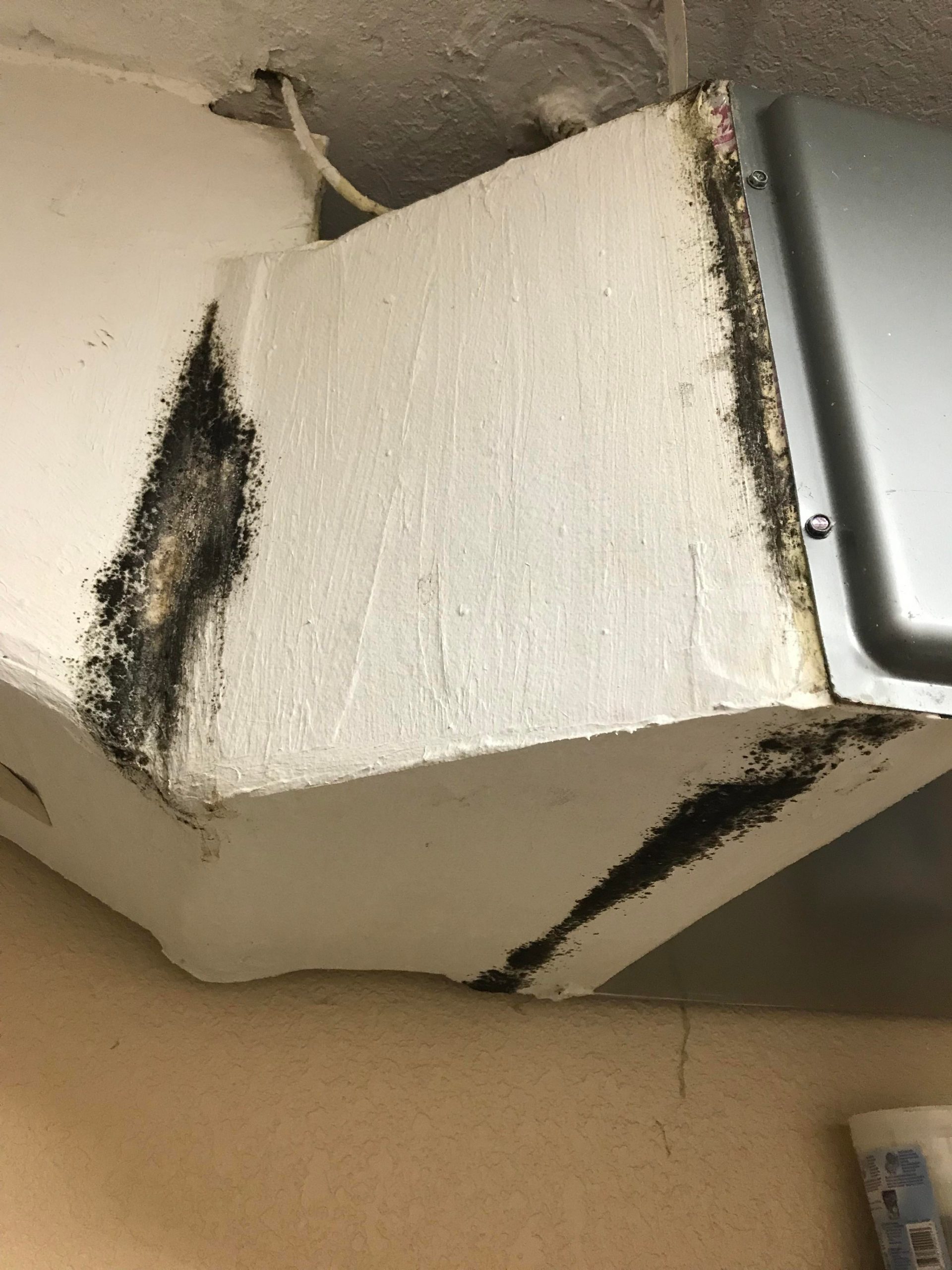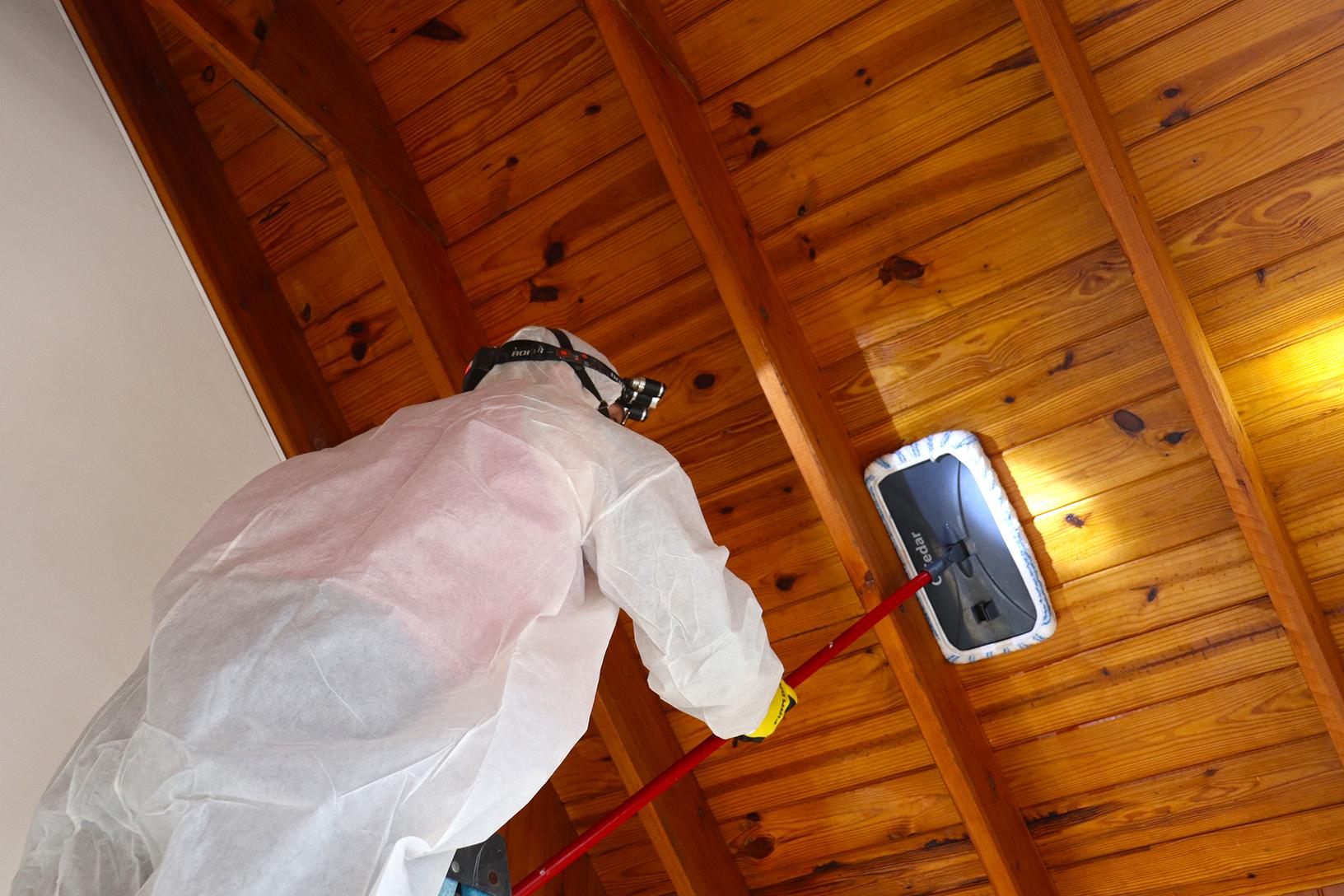Prepare The Room And Clean The Walls
When you are ready to remove Mold from the walls, clean the area. Be sure to remove all furniture, fabrics, and electrical appliances from the affected area. Then cover the bottom with plastic sheeting for protection.
Then use a damp sponge with dish soap and scrub the affected area to remove any dirt.
It is recommended to wear protective clothing before cleaning or treating the wall with any product. Safety glasses, rubber gloves, and a face mask protect you from Mold. You should also keep windows and doors open while removing Mold.
Learn More: How To Remove Sand Texture From Walls
If You Have Mold In Your Home
Mold can look like spots. It can be many different colors, and it can smell musty. If you see or smell mold, you should remove it. You do not need to know the type of mold.
If mold is growing in your home, you need to clean up the mold and fix the moisture problem. Mold can be removed from hard surfaces with household products, soap and water, or a bleach solution of no more than 1 cup of household laundry bleach in 1 gallon of water.
Black Mold Removal Using Essential Oils
Essential oils have mcade aromatherapy a household word, but these natural compounds can do so much more. Tea tree oil is an insect repellant, antiseptic, and deodorizer and its one of the safest methods for getting rid of black mold. Tea tree oil is a natural fungicide that cleans up mold quickly and it helps prevent mold spores from coming back.
Combine one teaspoon of tea tree oil with one cup of water in a spray bottle and shake vigorously to blend the water and oil. Spray the moldy area, leave it to dry for an hour, and then wipe away with a microfiber cloth or dry towel. Make sure to wear protective gloves, because some people find that essential oils can irritate their skin.
Also Check: How To Get Mold Off Shower Grout
Mold Removal From Fabric
Its easier than you might think for clothes to attract mold and mildew. A forgotten load of laundry in the washing machine, the pile of clothes at the bottom of a closet, or even the armchair in a humid room can all quickly become overrun with mold. However as long as you catch the problem early, your fabrics can still be saved.
Bleachable fabrics
If you can apply bleach to a fabric without worrying about discoloration, do it. Thats the fastest and most effective way of getting rid of mold. Many laundry bleaches can be used on white and colorfast fabrics, although you should always check the instructions, and never use bleach on wool or silk. Simply apply a solution of one part bleach to three parts water and let it absorb into the fabric for a few minutes before laundering as usual.
Non-bleachable fabrics
For fabrics that cant be bleached, use white vinegar instead. Either apply white vinegar to a cotton pad and place it on top of the stain for five minutes before laundering, or briefly soak in a solution of ¼ cup vinegar to one gallon water. Rinse through to remove the vinegar and launder as normal.
Upholstery
Related: All about cleaning fabrics
Mistakes To Avoid While Mold Cleanup

When doing mold remediation on your own, make sure to avoid the following mistakes:
- Choosing the wrong mold cleaner. Again, bleach is not what kills mold. Cleaning mold with bleach is not going to help. The best way to clean mold is by using natural products like the ones mentioned above.
- Not addressing cross-contamination. Heres one important thing you should know. Once you start scrubbing off the mold from the surface, some of the spores will become airborne. This means that your entire home can be exposed to mold infestation. Thus, it is essential to containing the area. Dispose of all the cleaning materials and clothing you used to prevent cross-contamination.
- Not eliminating the moisture source. No matter how hard you clean the parts of your home infested by mold, it will just keep coming back until you address the moisture problems. After the cleanup, speak with a mold remediation professional to determine the causes of water problems or leaks in your house.
You May Like: How To Kill Mold In My Basement
Tips On How To Remove Mold From Home
The first step is to locate and confirm the presence of mold. In addition to looking for the obvious discoloration spots, you can have your home tested for mold. According to homeadvisor.com, the average cost to test for mold is $834. However there are home mold-testing kits available for $10 to $50.
It is quite important that you remove the mold the moment you discover it, because the spores can affect the quality of air in your home. It is always advisable to hire a professional to remove the mold, but if you do it yourself, use an OSHA approved respirator, gloves, disposable coveralls, non-vented goggles. Listed below are a few tips on how you can remove mold from your house:
Remove moldy materials
If not properly disposed of, moldy materials may stir up spores, which can spread into your house. Because of their microscopic size, a square foot of wall can have over 3,000 million mold spores. You have to use the appropriate equipment and follow the safety procedures so as to protect yourself from the spores.
Excessive levels of contamination may require that you discard absorbent materials such as carpets, wall paper etc. To avoid airspore becoming airborne, professionals seal off the affected area with tape, and use plastic sheets to seal doorways and vents. They also use air movers, dehumidifiers and HEPA air scrubbers to eliminate moisture and dry out the air and surfaces.
Heating, Insulation and Ventilation
Find and fix interior plumbing leaks
Check the ductwork
How Do I Reduce The Smoke Smell In My Home
If you don’t have the budget for an air filtration system for your home right now, that’s okay. You can use these strategies to reduce the presence of smoke and VOCs in your home.
One of the simplest and most affordable methods of removing cigarette smoke and other airborne contaminants from the room is using the liquid air cleaner. This system contains liquid with aromatized drops added to it. The liquid sits in a bowl, and a fan pulls air through the liquid, scrubbing it clean of contaminants before releasing it into the room.
These units are more affordable than air-con systems or portable units, and they are somewhat effective at removing most airborne contaminants and VOCs in the air.
If you have smokers living in the house, convince them to smoke outdoors. Preventing smoking indoors stops the contaminants from releasing into the air and sticking to surfaces around the home. However, it’s important to note that formaldehyde will also adhere to the walls and surfaces in the smoker’s outdoor smoking area.
Keeping your home clean is vitally important for reducing the contaminants on surfaces and upholstery. Make sure you order a vacuum cleaner with a HEPA filter to remove as much dust and particulate matter from the air as possible.
Also Check: Kill Mold In Washing Machine
How To Clean Mildew
To clean moldy carpets, start by thoroughly vacuuming the affected carpet to remove as much of the mildew as you can. After you are done, either throw away the bag or clean the canister outside. Then proceed to clean the carpet as follows.
How To Remove Locker Room Shower Mold
The most effective way to remove mold from locker rooms is to kill it completely with bleach. Mix bleach with water at a 1:8 ratio in a spray bottle to make clean-up easy, convenient and safe. Mold spores can become airborne, and using a bottle with spray spout can prevent the inhalation of mold. Use a strong scrubber or brush to scour the mold from surfaces and grout, then rinse with water.
Another method for removing mold involves ordinary items you may find lying around your facility, depending what kind of commercial setting you work in. If you dont, theyre all easy to purchase at any grocery store. For example, vinegar is a mild acid that can kill some species of mold. Baking soda is often used in conjunction with vinegar because it absorbs odors and moisture, and it also helps to break up dirt and grime on tile and in grout. Hydrogen peroxide and tea tree oil have also been touted as having anti-bacterial and mold-repellent properties.
Also Check: How To Install Vinyl Stair Nose Molding
Tips For Preventing Mold On Walls
The most effective way to prevent mold and mildew from growing on your walls is to control moisture in your property. You can minimize the humidity within your home by using a dehumidifier and ensuring all rooms are well ventilated.
Condensation can also cause mold in your home. However, you can help to prevent it by insulating roofs, windows, exterior walls, and pipes.
Bathrooms and kitchens are particularly prone to mold and mildew. Ensure that these rooms are cleaned regularly to prevent spores from growing.
How Do You Get Rid Of Mold
There are plenty of commercial products that are effective for black mold removal, but many of them contain harsh chemicals that may be as harmful as the mold itself. There are several ways to get rid of mold without resorting to toxic chemicals.
Here are 5 ways to treat black mold using green household cleaners:
You May Like: Mold On Boat Seats
Getting Rid Of Basement Mold
Mold in the basement can be persistent, given the nature of basements they tend to be much more humid than above-ground levels and typically have poor ventilation and little air flow, a combination that can cause mold to flourish. And of course, basements can be prone to flooding, due to extreme weather or undetected leaks in the pipes or sump pump. In addition, once mold develops, cinder blocks or concrete walls can be difficult to clean due to their rough texture.
To get rid of mold in the basement, scrub the walls using a large brush, and keep in mind that porous surfaces such as ceiling tiles or drywall might need to be removed and replaced. If basement carpet has become moldy, sweep it to loosen the mold and let it dry in the sun if you can move it, or use high-powered fans to remove moisture if its affixed to the floor.
To prevent mold in the basement, you need to alter the conditions that can cause it to grow. First, remove dampness by installing a dehumidifier and making sure the dryer vent exhausts externally, if you use your basement for laundry. Then turn your attention outside: Shore up cracks and other foundation issues, and make sure that your soil is properly graded so that rainwater or melting snow goes away from the house, rather than collecting near your foundation.
How To Remove Mold From Shower Curtains And Liners

- If your shower curtain or liner is plastic, a mold and mildew spray thats safe for plastic, like Clorox Tilex Mold and Mildew Remover, can be used to get rid of mold. Simply spray on, wait until the stains disappear and rinse off.
- Another option: Wash your plastic liner in the washing machine on the delicate cycle with warm water, laundry detergent and bleach. If the shower curtain is fabric, its best to wash it on the warmest setting possible according to the care instructions.
Don’t Miss: Cleaning Mildew From Boat Seats
Techniques For Cleaning Surface Mold
Surface molds grow in just about any damp location, such as the grout lines of a ceramic tiled shower. They’re easy to scrub away with a mold cleaner mixture of 1/2 cup bleach, one quart of water and a little detergent. In mold remediation, the bleach in the cleaning mixture kills the mold. The detergent helps lift it off the surface so you can rinse it away and it won’t return as fast.
- Even for simple cleaning, protect yourself from contact with mold and the bleach solution by wearing a long-sleeve shirt and long pants as well as plastic or rubber gloves and goggles.
- If the mold doesn’t disappear after light scrubbing, reapply the cleaning mix and let it sit for a minute or two. Then lightly scrub again for mold remediation.
- Seal the clean surfaces when they’re thoroughly dry to slow future moisture penetration. Apply a grout sealer to tile joints to help your how to remove mold project
Note: Do not mix ammonia or any detergent containing ammonia with bleach. The combination forms a poisonous gas.
Aeramax 300 Large Room Air Purifier
AeraMax 300 is designed ideally for people who want a mold air purifier for their large rooms but are economically conscious. It comes fitted with HEPA filters together with activated carbon to trap all pollutants from your indoors. This means that it clears 99.97 percent of the allergens and pathogens.
It comes with four speeds with the lowest speed being the most silent and most economical. At this setting, the unit consumes only 6W of energy, which means that you will save on energy bills. However, if you are removing molds and mildew, you have to use the highest speed setting that will consume 86W.
The device comes with a 3-year warranty, which provides enough time for you to decide whether the purifier is best for you.
WHY WE LOVE IT
Also Check: How To Remove Mold From Leather Bag
What To Do If Your House Has Mold Health Risks And Tips To Remove Mold
Mold builds up in damp and poorly ventilated areas. On average, a person spends about 12 to 16 hours a day at home, especially children and senior citizens.
Inhalation of mold fragments or spores can cause airway inflammation, which can result in nasal congestion, wheezing, chest tightness, coughing and throat irritation.
According to the World Health Organization , continuous exposure to high levels of indoor dampness and mold can lead to a decrease in lung functionality, and may result in chronic respiratory conditions. People who are asthmatic or allergic can face a higher risk of severe symptoms when exposed to mold.
Aside from visible mold, other indications of dampness problems include mold odor, water stains, cracked wallpaper, wet basements, and so on.
How To Get Rid Of Mold On Walls
Mold on your interior walls can be a hint that youve got a water problem. Behind that wall, you may have a leaky pipe or a drainage issue. Or it could mean you have a ventilation issue. Does the bathroom have a vent? If not, moisture may be building up whenever you shower, encouraging mold growth.
If there is a water problem, any mold you kill by scrubbing is only going to come back. Fix these problems first. If you suspect a leak, clean the area and see how quickly the mold comes back. If it pops up quickly, you may need to hire someone to fix the problem.
To scrub mold off your walls, use a heavy-duty sponge soaked in a bleach/water solution. While wearing a protective mask and gloves, scrub the tainted spot with your solution. For stubborn patches of mold, you may need to let the solution soak in for a few minutes. If that still doesnt work, you can use specially formulated mold remover and mix it in with your bleach solution. Once done scrubbing, make sure to dry off the area you scrubbed.
Read Also: Spray Paint Mold Killer
Concrobium 27400 Mold Control Aerosol 141 Ounce
| Was: |
| Get Fast, Free Shipping with |
| You Save: |
- by entering your model number.
- Eliminates, cleans and prevents mold and musty odors
- Contains no bleach, ammonia or volatile organic compounds
- Penetrates to the roots of mold
- Works on drywall, concrete, wood, masonry, siding, shingles, stone, grout, plastic, tile and many more surfaces
- Ideal for basements, bathrooms, laundry rooms, attics, closets, garages, windows, car interiors, boat interiors and rvs
- Note: Packaging may vary
Question 7 Of : Can I Paint Over Mold And Mildew
Read Also: How To Clean Mold Off Bathroom Ceiling
Attack Your Tack Room To Really Prevent Mold And Mildew
- Clean the walls, ceilings, and floors with a bleach solution. The material of your construction will dictate the dilution ratio of bleach to water. For example, for painted wood: 3/4 cup bleach to gallon water and for concrete and unpainted wood: 1:3 bleach to water.
- Rinse all surfaces with clean water when you are done. You can do a quick internet search for more specifics. The point is to rid your tack room of it. If you have a rug in the tack room, consider using it only in dry months.
A simple and small dehumidifier is great for tack and feed rooms to combat moisture, mold, and mildew.
Does The Dehumidifier Remove Moisture

The dehumidifier is designed to reduce the level of humidity in the air by removing excess water. An inexpensive hygrometer lets you continually monitor the moisture levels in your basement, so you can keep them at an ideal 60% by running a dehumidifier. So, dehumidifiers can help prevent mold growth and improve indoor air quality.
Recommended Reading: Black Mold In Grout
